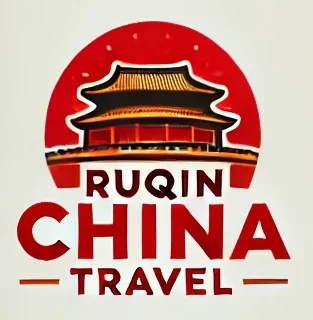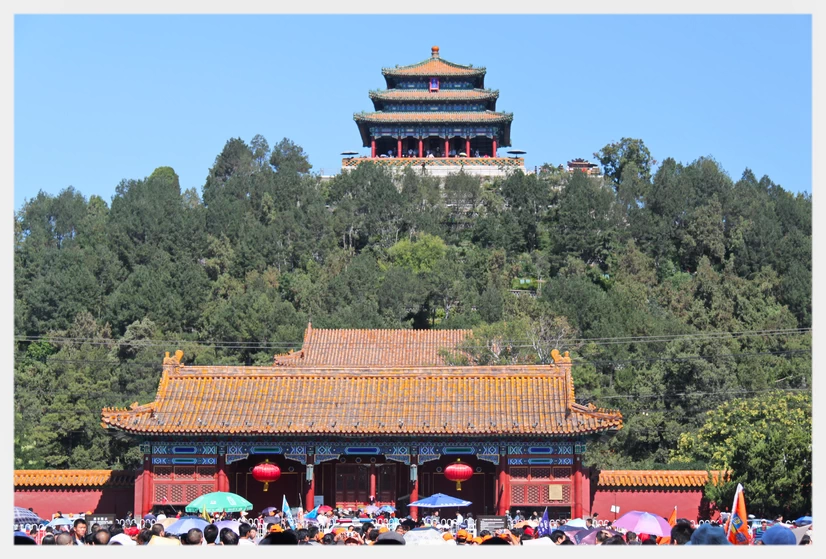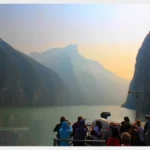In this complete guide, we’ll cover everything you need to know about how to visit Jingshan Park, from its historical significance to insider tips and recommended walking routes.
Jingshan Park, located just north of the Forbidden City, is a must-visit destination for anyone exploring Beijing. This peaceful, scenic park offers stunning views, rich history, and a unique experience for travelers. Whether you’re looking for the best vantage point of the Forbidden City or a relaxing spot to unwind, Jingshan Park has it all.
1. Jingshan Park History and Facts
Before diving into how to visit Jingshan Park, it’s essential to understand its rich history. The park was originally a royal garden during the Yuan, Ming, and Qing dynasties. Built in the 11th century, Jingshan Hill was man-made using the earth excavated from the construction of the Forbidden City’s moat. The hill, known as “Prospect Hill,” stands at 45 meters high and is the tallest point in central Beijing.
One of the park’s most famous historical events took place in 1644, when the last Ming Dynasty Emperor, Chongzhen, hanged himself on a tree here. Desperate after Beijing fell to rebel forces, he ended his life, marking a dramatic turning point in Chinese history. Today, Jingshan Park remains a symbol of imperial history and a peaceful place for visitors.
2. How to Get to Jingshan Park
Jingshan Park has three main entrances: the South, East, and West Gates. The South Gate is directly across from the Forbidden City. The West Gate also leads to the eastern entrance of Beihai Park.
Address: 44 Jingshan West Street, Xicheng District, Beijing.
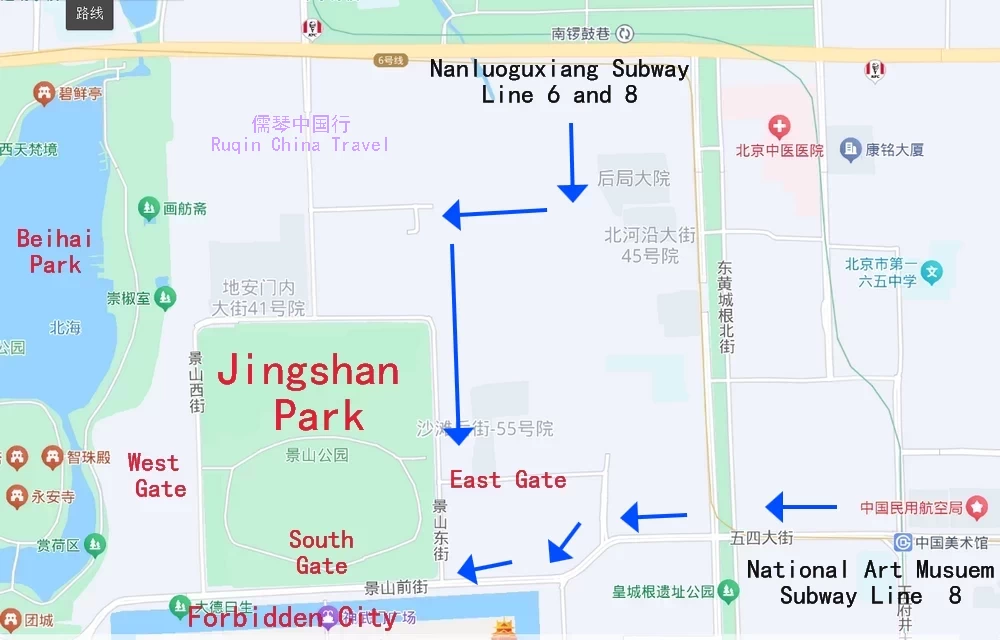
By Subway
The closest subway stations to Jingshan Park are Nanluoguxiang Station (Lines 6 & 8) and National Art Museum Station (Line 8). Both are just a few minutes’ walk from the park’s entrances.
By Bus
- South Gate: Take bus routes 101, 103, 109, 124 (electric trolley), 58, or the special tourist lines Special 1 and Special 2.
- East Gate: Buses 111, 124, and 210 pass by the East Gate.
- West Gate: Bus routes near the West Gate include 5, 58, 101, 103, 124, Sightseeing Line 1, Sightseeing Line 2, 109, 685, 111, 13, 3, 612, 701, 107, 118, and 42.
By Taxi or Ride-Hailing
Taxis are easy to find in Beijing. You can simply hail one and ask the driver to take you to Jingshan Park (景山公园, jǐngshān gōngyuán) or show them the address in Chinese. Alternatively, use ride-hailing apps like Didi to book a ride directly to the park.
By Bicycle
Beijing has an extensive bike-sharing system. You can find bike stations near Jingshan Park. Renting a bike is a great option if you prefer a more active way to get there.
By Walking
If you’re staying in the city center, walking to Jingshan Park is easy. It’s just north of the Forbidden City, within walking distance from popular spots like Tiananmen Square and Wangfujing Street.
Tip
When using public transport, it’s helpful to have the park’s name written in Chinese characters or a map with the location marked. This will make it easier to communicate with taxi drivers or ensure you’re on the right bus or subway.
3. Jingshan Park Tickets and Opening Hours
Jingshan Park has a modest entrance fee, making it an affordable destination for foreign tourists. The entrance fee is just 2 RMB, with a discount for students and seniors. The park is open daily from 6:00 AM to 9:00 PM in the summer months and from 6:30 AM to 8:00 PM in winter.
It’s worth noting that early mornings and late afternoons are the best times to visit if you want to avoid the crowds. Additionally, mornings offer cooler temperatures, especially during the hot Beijing summers.
Entrance Ticket: RMB 2 / per person
(RMB10 /person during Peony Festival in April and May)
Opening Hours
06:30-21:00; Closing time :20:30 (Monday – Sunday; April 1 – October 31)
06:30-20:00; Closing time :19:30 (Monday – Sunday; November 1 – March 31)
On-site Ticket Booking: Yes
Advance Booking: 1 – 7 days
Official Booking Platform: Reserve Tickets for Jingshan Park and WeChat App.
4. Best Time to Visit Jingshan Park Beijing
To truly savor the magic of Jingshan Park, timing is key. The best seasons to visit are spring and autumn, each offering its own unique charm. In spring, the park comes alive with colorful blooms, filling the air with fresh scents and providing a vibrant backdrop for your walk. Come autumn, the park transforms into a sea of golden and red leaves, and the cooler temperatures create a perfect setting for exploration.
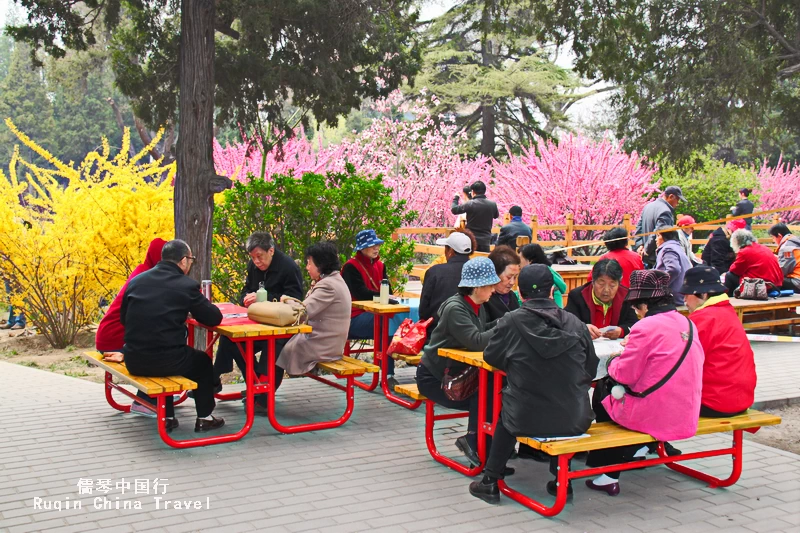
Though Jingshan Park is a year-round destination, summer is best avoided. The heat in Beijing can be intense, and the summer holidays bring large crowds of domestic tourists, including families with students. Winter, however, has its own appeal. It’s peaceful and quiet, offering solitude in a snow-dusted park, but do be prepared for brisk winds atop Jingshan Hill.
Suggested Timing and Visit Recommendations
Early Morning (Around 8:30-9:00 AM):
For a serene experience, arrive early to beat the crowds. The park’s calm beauty at this time of day is truly refreshing. Start with a visit to Qiwang Tower, where you can immerse yourself in the fascinating history and culture of the park.
Late Afternoon (Around 4:00-5:00 PM):
If you’re looking to catch the sunset, the late afternoon is the perfect time. The park is small, so it only takes about 20 minutes to reach the best vantage point. The soft light and stunning views make this an unforgettable moment. Note: Try to avoid the weekends! So many tourists on weekends to ascend the summit for a full view of the Forbidden City.
5. Top Things to Do in Jingshan Park
Jingshan Park is the perfect place to catch a stunning panoramic view of the Forbidden City and Beijing’s central axis. The park is strategically positioned along the city’s north-south axis. To the south, it faces the iconic Shenwu Gate of the Forbidden City, separated only by a street. On the west side, Beihai Park lies just next door.
It sits atop a hill that rises 94.2 meters above sea level. This hill once marked the highest point along Beijing’s central axis, offering visitors a breathtaking perspective of the city’s most historic landmarks
1) Emperor Chongzhen’s Final Moment
Emperor Chongzhen‘s final act took place under an old, crooked acacia tree on the eastern slope of Jingshan Park. On March 19, 1644, in the early morning, the emperor, accompanied by his eunuch Wang Cheng’en, climbed Coal Hill (Jingshan). There, at just 33 years old, he took his own life, hanging himself from the tree.
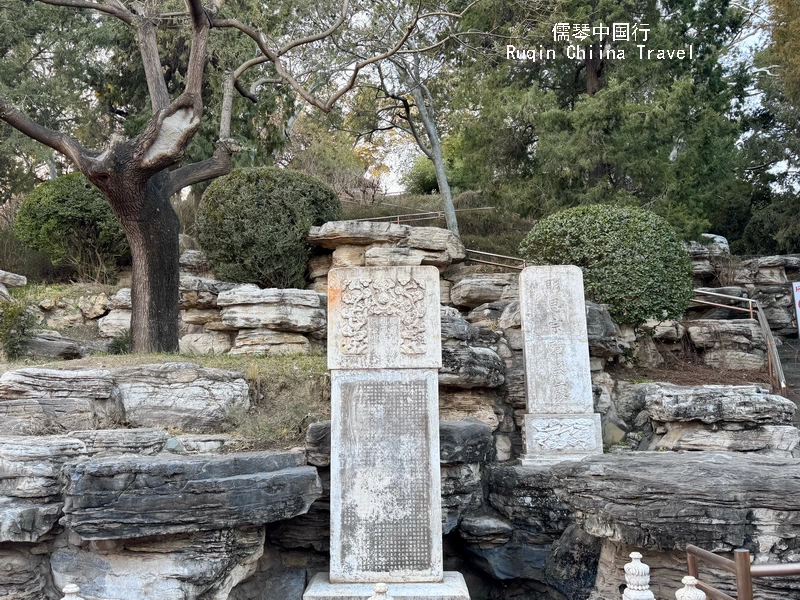
Today, this spot is not only a poignant historical site but also a place where visitors come to reflect. Every year, countless people visit to learn about this tragic chapter of Chinese history and pay homage to the fallen emperor.
2) Exploring the Five Pavilions on Jingshan Hill
One of the most striking features of Jingshan Park is the five pavilions that crown the hill, each offering a unique perspective of Beijing. These pavilions—Zhou Shang, Guan Miao, Wan Chun, Ji Fang, and Fu Lan—are strategically positioned at the east, south, west, north, and central points of the hill, respectively.
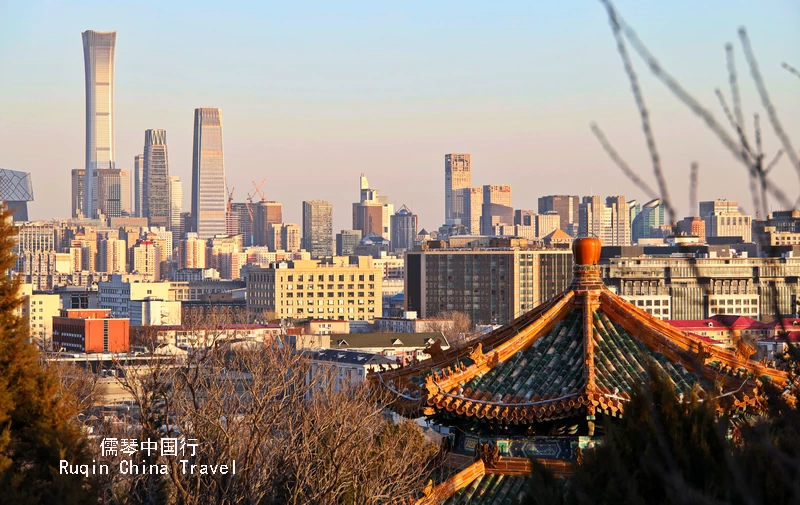
More than just places to rest, these pavilions are steeped in history and offer a glimpse into Beijing’s cultural past.
- Zhou Shang Pavilion (周赏亭): Perched at the easternmost peak, this pavilion features a beautiful peacock-blue glazed tile roof and purple crystal-colored edges. Its double-eaved, pointed design makes it a striking landmark. From here, you get an excellent view of Beijing’s eastern skyline.
- Guan Miao Pavilion (观妙亭): Located on the second peak from the east, this pavilion boasts an emerald-green roof with yellow edges. The double-eaved, octagonal design is both elegant and unique. It offers another incredible vantage point to view the eastern side of the city.
- Wan Chun Pavilion (万春亭) : As the highest pavilion on Jingshan, Wan Chun sits at the peak of the hill, right at the center of Beijing’s central axis. With its yellow and green glazed tile roof and triple-eave design, it is the best spot for panoramic views. On clear days, you can see the entire Forbidden City spread out before you, making it the highlight of any visit.
- Ji Fang Pavilion (辑芳亭): Slightly west of the center, it offers stunning views of the western side of Beijing, adding another layer to your exploration of the city’s landscapes.
- Fu Lan Pavilion (富览亭): Located on the westernmost peak, from here you can enjoy sweeping views of the western part of the city, offering yet another perfect perspective of Beijing’s beauty.
Each pavilion, with its distinct architecture and rich history, is not just a resting spot but also a living witness to Beijing’s past. Whether you’re admiring the intricate design or soaking in the view, these pavilions are a must-see for anyone exploring Jingshan Park.
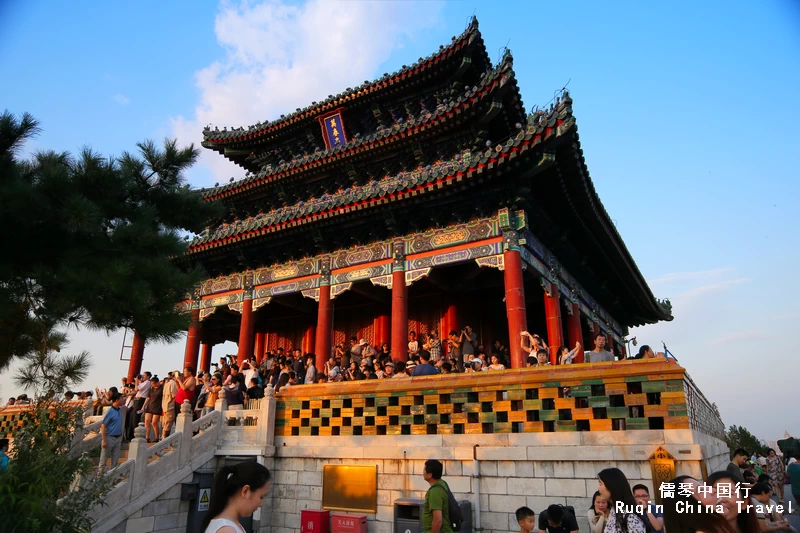
The park’s five pavilions also represent the five elements of traditional Chinese philosophy: metal, wood, water, fire, and earth.
3)Best Views of the Forbidden City from Jingshan Park
Jingshan Park offers some of the best views of the Forbidden City, drawing tourists from all over. At the top of Jingshan Hill, the sight is simply breathtaking. The golden rooftops of the Forbidden City stretch out before you, creating a stunning panorama.
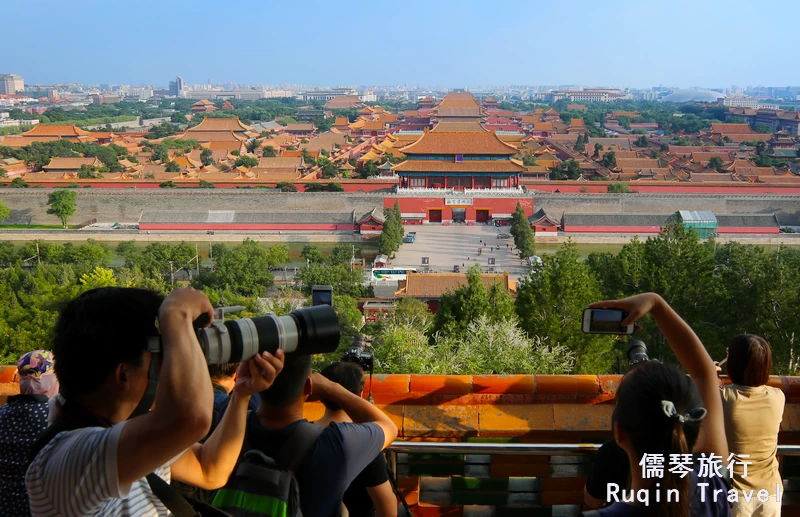
The view is especially magical during sunrise or sunset. As the sun rises or sets, the palace glows with a warm, golden light. The colors change with the sky, casting a serene atmosphere over the ancient buildings. It’s a moment that feels timeless, as if the Forbidden City is whispering its secrets to those who stand in awe.
4) Enjoy the Full Views of the City of Beijing
From the top of Jingshan Hill, you get more than just a stunning view of the Forbidden City. The panoramic vista stretches across the entire city. To the north, you can see the Central Axis of Beijing, with the iconic Drum and Bell Towers standing proudly. Beyond them, the Olympic Park comes into view, adding a modern touch to the historical landscape.
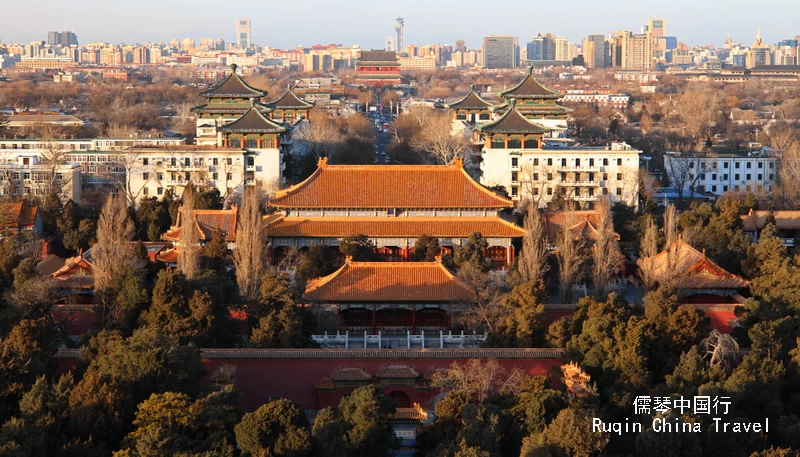
Looking west, the view includes the White Pagoda in Beihai Park, along with the distinctive CCTV Tower. Both landmarks stand out against the skyline, blending the old with the new.
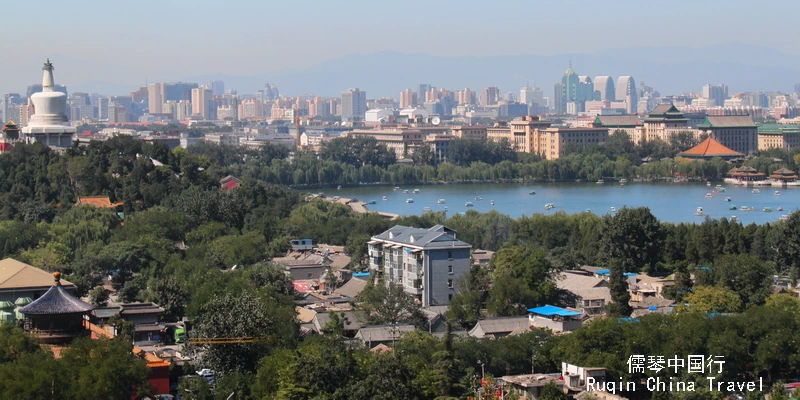
To the east, the city’s highrises rise above the bustling CBD. The sleek glass towers reflect the energy of Beijing’s commercial heart.
For photography lovers, Jingshan Hill is an absolute treasure. The sweeping views from Wanchun Pavilion offer a perfect opportunity to capture Beijing’s vast cityscape. Be sure to bring your camera—this spot offers some of the best panoramic shots you’ll find in the city.
5) The Peony Flower Show in Spring
Jingshan Park offers more than just stunning views—it’s a lively place filled with activity and charm. Locals often gather here to practice tai chi, dance, and sing. It’s a wonderful chance for visitors to experience the daily life of Beijingers. You can join in, or simply sit back and enjoy the vibrant atmosphere.
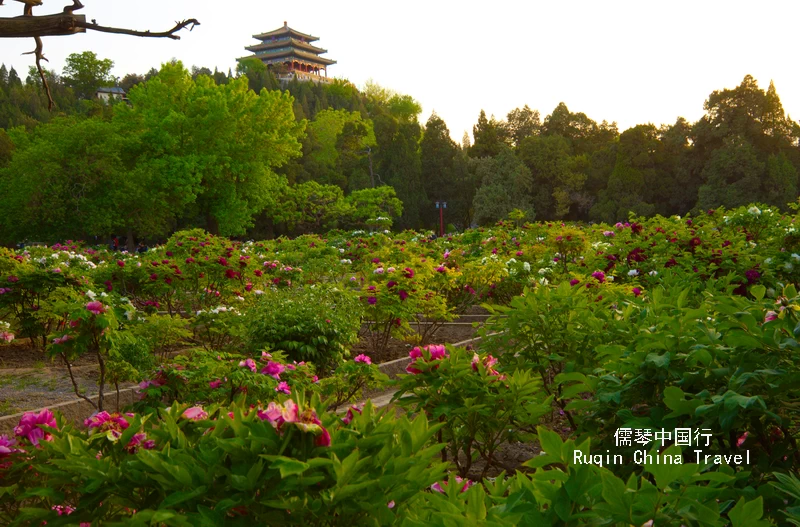
Spring is a particularly special time in the park. When April and May roll around, the peonies bloom in full splendor. The flower gardens are a sight to behold, with colorful petals creating a striking contrast against the green landscape. A stroll through these gardens is the perfect way to soak in the beauty of the season.
If you’re lucky enough to visit during the peony season, make sure to take your time and wander through the blooming flowers. The air is fragrant, and the scenery is simply breathtaking. It’s an experience that adds a peaceful, picturesque layer to your visit to Jingshan Park.
6. Jingshan Park Hiking Routes
Jingshan Park offers more than just a great view of the Forbidden City. It’s also an ideal place for a relaxing hike with two distinct routes to the summit. Both entrances provide a unique experience, depending on your starting point.
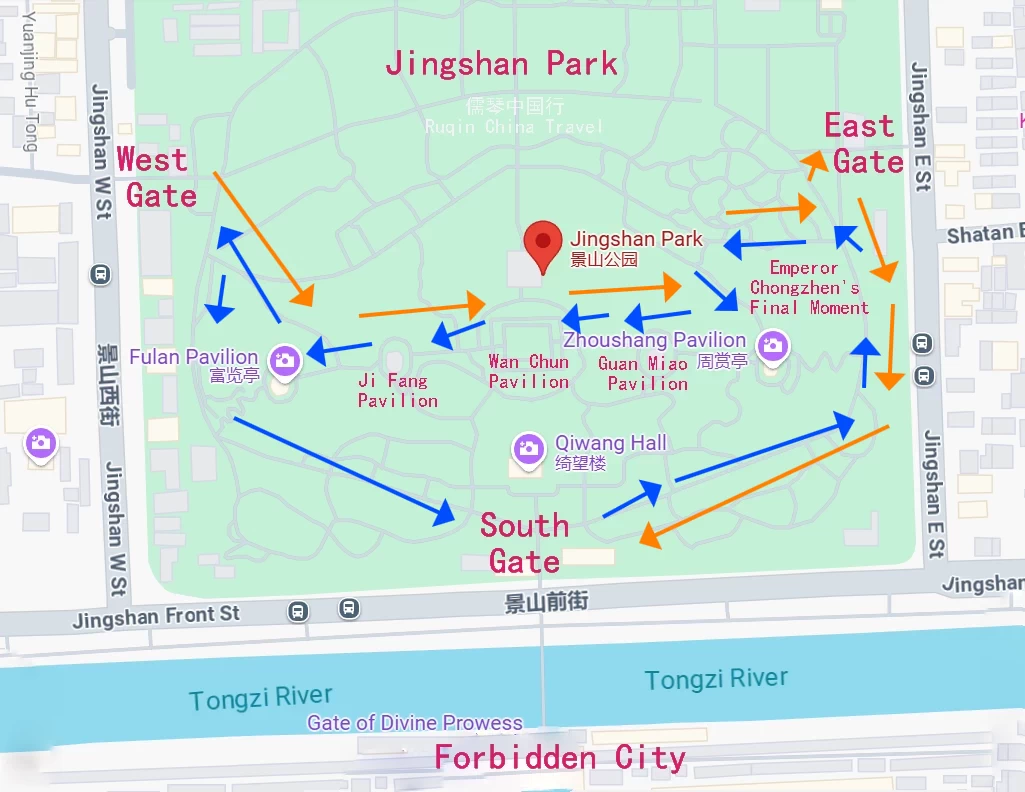
West Gate Entrance: A Quick Ascent
If you enter from the West Gate, your journey starts with a short walk. After turning right and walking about 50 meters, you’ll arrive at the first climbing entrance. This is the fastest route to the top, making it a perfect choice for visitors who haven’t reserved tickets to the Forbidden City. The West Gate is closest to Wanchun Pavilion, where you can enjoy a 360-degree view of the Forbidden City. From here, the sprawling palace complex unfolds before you like a golden sea of rooftops, a sight you won’t forget.
As you walk along the path, you’ll pass three charming pavilions. Take a moment to stop at Wanchun Pavilion—it’s the best spot for panoramic photos of the Forbidden City. The golden roofs of the palace seem to stretch endlessly, framed by the city’s skyline.
South Gate Entrance: A Historical Path
For those entering from the South Gate, the route is slightly longer but equally rewarding. After entering, turn right, and you’ll soon reach the spot where Emperor Chongzhen tragically ended his life. Follow the signs leading up the hill, and you’ll eventually reach Wanchun Pavilion. This route is particularly great for visitors who have just explored the Forbidden City, as it offers a more leisurely climb.
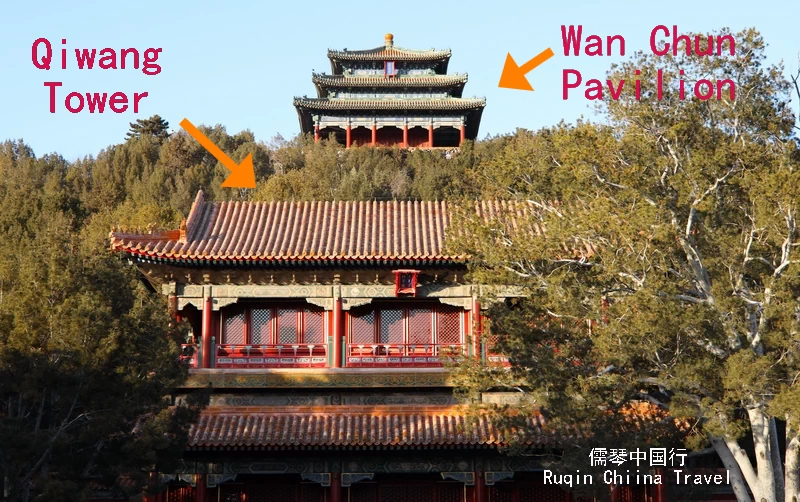
Along the way, you can stop at the Chongzhen Memorial Site and Qiwang Pavilion. These historical landmarks provide insight into China’s past and add a cultural layer to your hike. But the ultimate reward is the view from Wanchun Pavilion, where you’ll be treated to the most spectacular sight of the Forbidden City below.
Timing Your Visit for the Best Views
To get the most out of your hike, aim to reach the summit between 5:00 PM and 7:00 PM. This is the golden hour when the light is perfect for capturing the beauty of both the Forbidden City and the wider cityscape. You’ll see the CBD’s skyscrapers, the iconic White Pagoda, and even the towering TV Tower, all bathed in a warm, glowing light.
No matter which route you take, Jingshan Park offers not just a hike but an experience. Whether you’re here for the history, the view, or just a peaceful escape in the heart of Beijing, you’re in for a treat.
7. Nearby Attraction and City Walk
Jingshan Park, with its panoramic views of the Forbidden City, is the perfect starting point for a leisurely city walk that uncovers some of Beijing’s lesser-known but fascinating attractions.
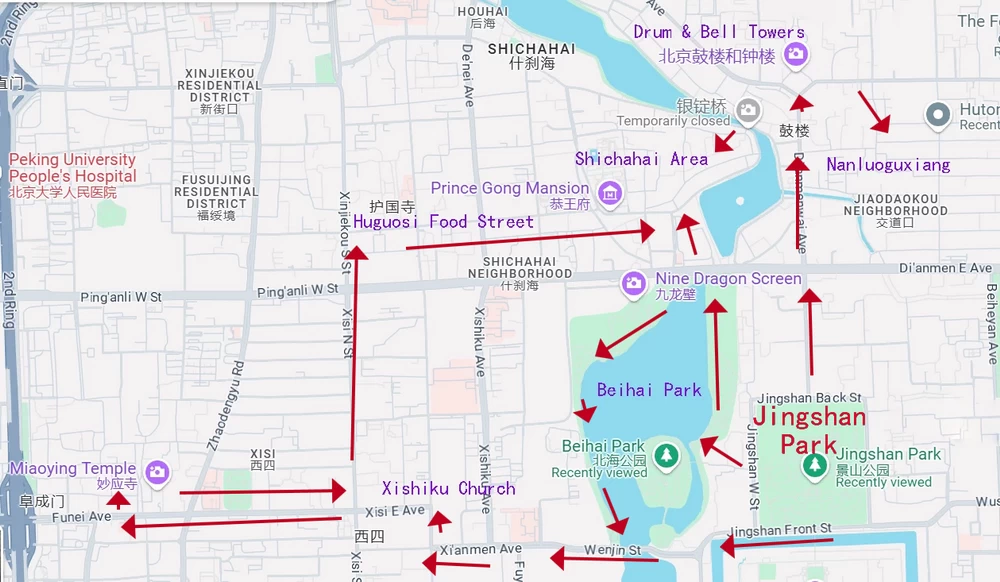
To the west of the park, you’ll find the serene Beihai Park, a peaceful escape with its beautiful lake and ancient architecture. Stroll along the water, visit the White Pagoda, and enjoy the quiet charm of this historic park. Just nearby is Wenjin Street, lined with traditional Beijing-style homes, offering a glimpse of local life and culture.
If you walk further west, you’ll reach the impressive Xishiku Church, a striking Gothic-style building that adds an unexpected touch of European flair to the city. The church is an architectural gem, and its peaceful ambiance is a perfect contrast to the bustling streets of Beijing.
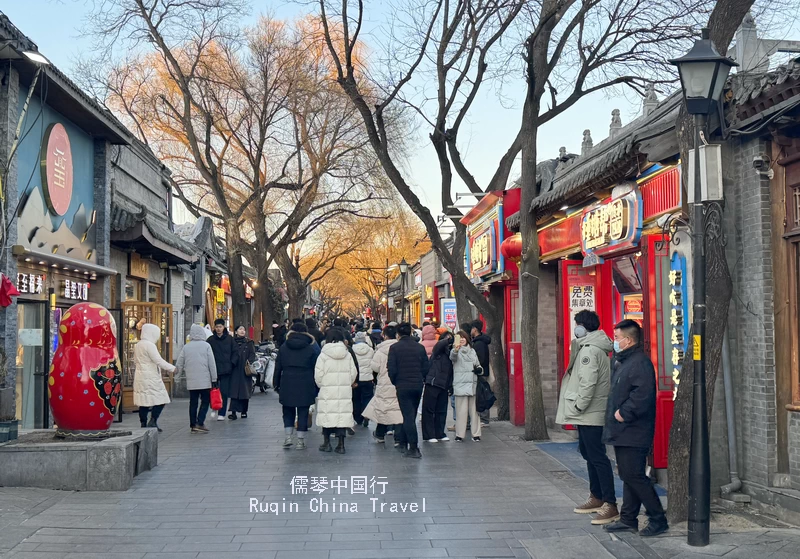
To the north, a walk through Shichahai takes you past charming ancient lanes (hutongs) and peaceful lakes, where locals gather to enjoy leisurely boat rides. Nearby, the lively Nanluoguxiang offers a blend of trendy cafes, unique shops, and vibrant street art, perfect for a relaxed afternoon.
You can also visit the Drum and Bell Towers, which once marked the time for the whole city. This walk from Jingshan Park is a wonderful way to experience both the modern and traditional sides of Beijing.
Jingshan Park is a must-see destination for any traveler visiting Beijing. Whether you’re drawn to the breathtaking views of the Forbidden City, the peaceful gardens, or the historical significance of the park, there’s something for everyone to enjoy.
By following this guide on how to visit Jingshan Park, you’ll be prepared for an unforgettable experience. So, grab your camera, wear comfortable shoes, and get ready to explore one of Beijing’s most scenic and culturally rich parks.
More Beijing Travel Guides
Planning your Beijing tour? Our “Beijing Travel Guide“ section offers essential advice to help you navigate the city like a pro. From transportation tips and local customs to insider recommendations for hidden gems, these travel tips will ensure you have a smooth, enjoyable, and unforgettable experience in China’s vibrant capital. Let us guide you through the best practices for exploring Beijing with confidence!
